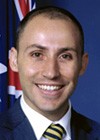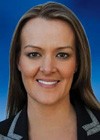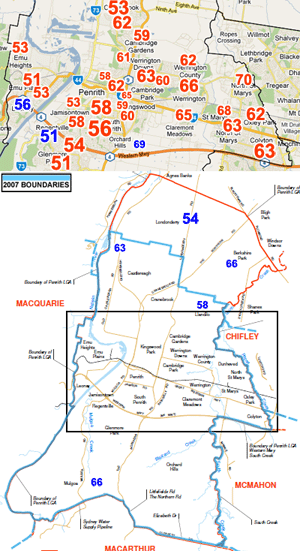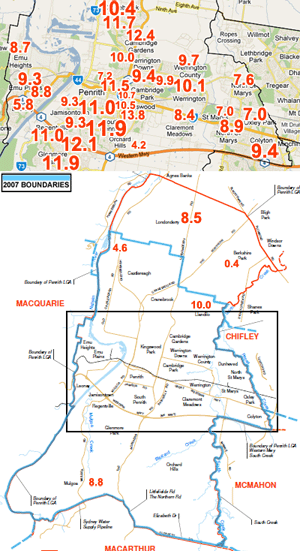Electoral Form Guide: Lindsay
Electorate: Lindsay
Margin: Labor 6.3%
Location: Outer Western Sydney, New South Wales
In a nutshell: Famed seat of Howard’s battlers and racist pamphlet shenanigans, Labor’s solid-looking margin is by all accounts highly deceptive in a seat primed for a backlash over asylum seekers and hostility towards the state government. David Bradbury will attempt to hang on in a seat he snared on the third attempt in 2007.
The candidates
|
|
DAVID BRADBURY
|
|
|
Two-party vote map
|
Swing % map |
Electorate analysis: The western Sydney seat of Lindsay has emerged as a favourite among journalists as a barometer of national opinion, owing to Labor’s surprise defeat in 1996 and their eventual success when they returned to power in 2007. Its place in electoral folklore was further cemented in the final days of the 2007 campaign when the husbands of outgoing Liberal member Jackie Kelly and her successor candidate Karen Chijoff were caught distributing pamphlets purporting to be from Muslim extremists, in which Labor was praised for its support of the “unjustly” treated Bali bombers. The electorate is based around Penrith 50 kilometres to the west of Sydney, from which it extends into conservative semi-rural territory to the north (Castlereagh and Llandilo) and south (Mulgoa and Orchard Hills). The redistribution has added 3700 voters around Londonderry from Greenway, which cuts the Labor margin by 0.5 per cent.
Lindsay had a notional Labor margin of 12.3 per cent when it was created in 1984, and the area remained solid for Labor at state level during the Howard era. Labor’s Ross Free held the seat by margins of around 10 per cent throughout the Hawke-Keating years, having previously been member for Macquarie from 1980. He was most unpleasantly surprised to find himself voted out in 1996, following an epochal 11.9 per cent swing to Liberal candidate Jackie Kelly. Free was able to secure a re-match because Kelly, who did not expect to win, had failed to get her affairs in order before nominating (she was still serving as an RAAF officer, an “office for profit under the Crown”). Voters dragged back to the polls on a technicality rewarded Free with a further 6.8 per cent drop in the primary vote, and Kelly picked up another 5.0 per cent on two-party preferred. The combined 16.9 per cent swing to the Liberals meant the electorate’s demographic profile came to be seen as typifying John Howard’s constituency – high numbers of skilled workers on good incomes, low levels of tertiary education and a distinctly less multicultural flavour than suburbs closer to the city.
Kelly was able to limit the Labor swing in 1998 to 0.3 per cent, one of a number of decisive marginal seat outcomes that ensured the return of the Howard government from a minority of the two-party vote. This secured Kelly’s status as a prime ministerial favourite, helping her win promotion to the position of Sport and Tourism Minister. Many thought this to be beyond her competence, and she did not return to the ministry after leaving it while pregnant immediately after the 2001 election. She nonetheless continued to perform well electorally, picking up a 2.4 per cent swing in 2001 and almost holding even in 2004. To John Howard’s dismay, Kelly opted to retire at the 2007 election, at which the seat was further endangered by a redistribution that cut the Liberal margin from 5.3 per cent to 2.9 per cent. No doubt helped along by the pamphlet scandal, there followed a resounding 9.7 per cent swing that finally delivered the seat to Labor.
The win marked third time lucky for David Bradbury, a Blake Dawson Waldron lawyer and former Penrith mayor, who had run unsuccessfully in 2001 and 2004. There were reports in 2009 that Bradbury was not of a mind to run in Lindsay for a fourth time, as he was concerned at the impact of the state government’s unpopularity and hoped the departure of Roger Price might provide a safer berth for him in Chifley. This was denied by Bradbury, but any concern he might have had seemed to be justified when Labor’s poll ratings tanked in the early part of 2010. Both parties’ polling was said to show the situation being particularly critical for Labor in Lindsay and surrounding areas. The point was emphasised when a state by-election for Penrith, located entirely within the seat, saw Labor annihilated by a 25 per cent swing. The particular sensitivity of asylum seekers as an issue in the electorate was demonstrated all too clearly when Bradbury accompanied newly anointed Prime Minister Julia Gillard for a photo opportunity on a patrol boat at Darwin, for no very good reason.
The interruption of the by-election resulted in what seemed an inordinately long delay in the Liberals choosing a candidate. It was only in the week before the campaign began that marketing manager Fiona Scott was endorsed in a preselection vote ahead of school teacher Margaret Grand by 31 votes to seven.
 In the middle of the campaign Newspoll published a survey of Lindsay voters which had the Liberals leading 51-49 on two-party preferred, from primary votes of 45 per cent Liberal and 41 per cent Labor. This compared with a Newspoll conducted in Kevin Rudd’s last days which had the Liberal lead at 56-41, although this was criticised for having been conducted on the same weekend as the Penrith by-election, at which state Labor was repudiated with a devastating 25 per cent swing. In the second last week of the campaign the electorate was one of four western Sydney marginals covered by a Galaxy survey targeting 200 respondents per electorate, which collectively showed what in the context of Lindsay was a manageable swing against Labor of 3.9 per cent. Earlier that week Patricia Karvelas of The Australian reported the Liberals were “not as confident” about Lindsay as other Sydney marginals.
In the middle of the campaign Newspoll published a survey of Lindsay voters which had the Liberals leading 51-49 on two-party preferred, from primary votes of 45 per cent Liberal and 41 per cent Labor. This compared with a Newspoll conducted in Kevin Rudd’s last days which had the Liberal lead at 56-41, although this was criticised for having been conducted on the same weekend as the Penrith by-election, at which state Labor was repudiated with a devastating 25 per cent swing. In the second last week of the campaign the electorate was one of four western Sydney marginals covered by a Galaxy survey targeting 200 respondents per electorate, which collectively showed what in the context of Lindsay was a manageable swing against Labor of 3.9 per cent. Earlier that week Patricia Karvelas of The Australian reported the Liberals were “not as confident” about Lindsay as other Sydney marginals.
Analysis written by William Bowe. Read Bowe’s blog, The Poll Bludger.





